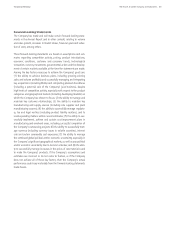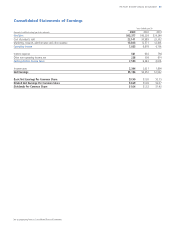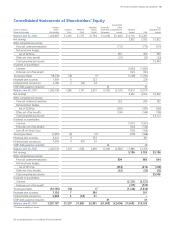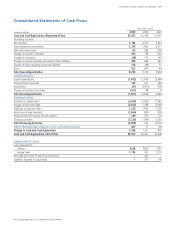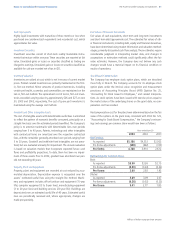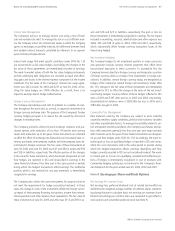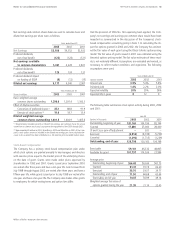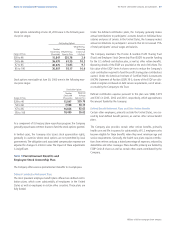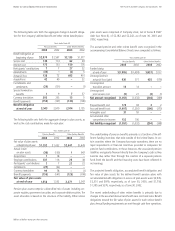Proctor and Gamble 2003 Annual Report Download - page 43
Download and view the complete annual report
Please find page 43 of the 2003 Proctor and Gamble annual report below. You can navigate through the pages in the report by either clicking on the pages listed below, or by using the keyword search tool below to find specific information within the annual report.
Notes to Consolidated Financial Statements 41The Procter & Gamble Company and Subsidiaries
Fair Values of Financial Instruments
Fair values of cash equivalents, short-term and long-term investments
and short-term debt approximate cost. The estimated fair values of oth-
er financial instruments, including debt, equity and financial derivatives,
have been determined using market information and valuation method-
ologies, primarily discounted cash flow analysis. These estimates require
considerable judgment in interpreting market data, and changes in
assumptions or estimation methods could significantly affect the fair
value estimates. However, the Company does not believe any such
changes would have a material impact on its financial condition or
results of operations.
Stock-Based Compensation
The Company has employee stock option plans, which are described
more fully in Note 8. The Company accounts for its employee stock
option plans under the intrinsic value recognition and measurement
provisions of Accounting Principles Board (APB) Opinion No. 25,
“Accounting for Stock Issued to Employees,” and related interpreta-
tions. As stock options have been issued with exercise prices equal to
the market value of the underlying shares on the grant date, no com-
pensation cost has resulted.
Had compensation cost for the plans been determined based on the fair
value of the options on the grant date, consistent with SFAS No. 123,
“Accounting for Stock-Based Compensation,” the Company’s net earn-
ings and earnings per common share would have been as follows:
Cash Equivalents
Highly liquid investments with maturities of three months or less when
purchased are considered cash equivalents and recorded at cost, which
approximates fair value.
Investment Securities
Investment securities consist of short-term readily marketable instru-
ments that mature within one year. These securities are reported at fair
value. Unrealized gains or losses on securities classified as trading are
charged to earnings. Unrealized gains or losses on securities classified as
available for sale are recorded net of tax in OCI.
Inventory Valuation
Inventories are valued at cost, which is not in excess of current market
prices. Product-related inventories are primarily maintained on the first-
in, first-out method. Minor amounts of product inventories, including
certain pet health, cosmetics and commodities are maintained on the
last-in, first-out method. The replacement cost of last-in, first-out inven-
tories exceeded carrying value by approximately $26 and $27 at June
30, 2003 and 2002, respectively. The cost of spare part inventories is
maintained using the average cost method.
Goodwill and Other Intangible Assets
The cost of intangible assets with determinable useful lives is amortized
to reflect the pattern of economic benefits consumed, principally on a
straight-line basis over the estimated periods benefited. The Company’s
policy is to amortize trademarks with determinable lives over periods
ranging from 5 to 40 years. Patents, technology and other intangibles
with contractual terms are amortized over the respective contractual
lives, with the remainder generally amortized over periods ranging from
5 to 20 years. Goodwill and indefinite-lived intangibles are not amor-
tized, but are evaluated annually for impairment. The annual evaluation
is based on valuation models that incorporate expected future cash
flows and profitability projections. To date, there has been no impair-
ment of these assets. Prior to 2002, goodwill was amortized over peri-
ods not exceeding 40 years.
Property, Plant and Equipment
Property, plant and equipment are recorded at cost reduced by accu-
mulated depreciation. Depreciation expense is recognized over the
assets’ estimated useful lives using the straight-line method. Machi-
nery and equipment includes office furniture and equipment (15-year
life), computer equipment (3 to 5-year lives), manufacturing equipment
(3 to 20-year lives) and building services (20-year life). Buildings are
depreciated over an estimated useful life of 40 years. Estimated useful
lives are periodically reviewed and, where appropriate, changes are
made prospectively.
Millions of dollars except per share amounts
Net Earnings
As reported
Pro forma adjustments
Pro forma
Net Earnings Per Common Share
Basic
As reported
Pro forma adjustments
Pro forma
Diluted
As reported
Pro forma adjustments
Pro forma
2001
$2,922
(310)
2,612
$2.15
(0.23)
1.92
2.07
(0.22)
1.85
2002
$4,352
(442)
3,910
$3.26
(0.34)
2.92
3.09
(0.32)
2.77
2003
$5,186
(398)
4,788
$3.90
(0.30)
3.60
3.69
(0.28)
3.41
Years ended June 30




